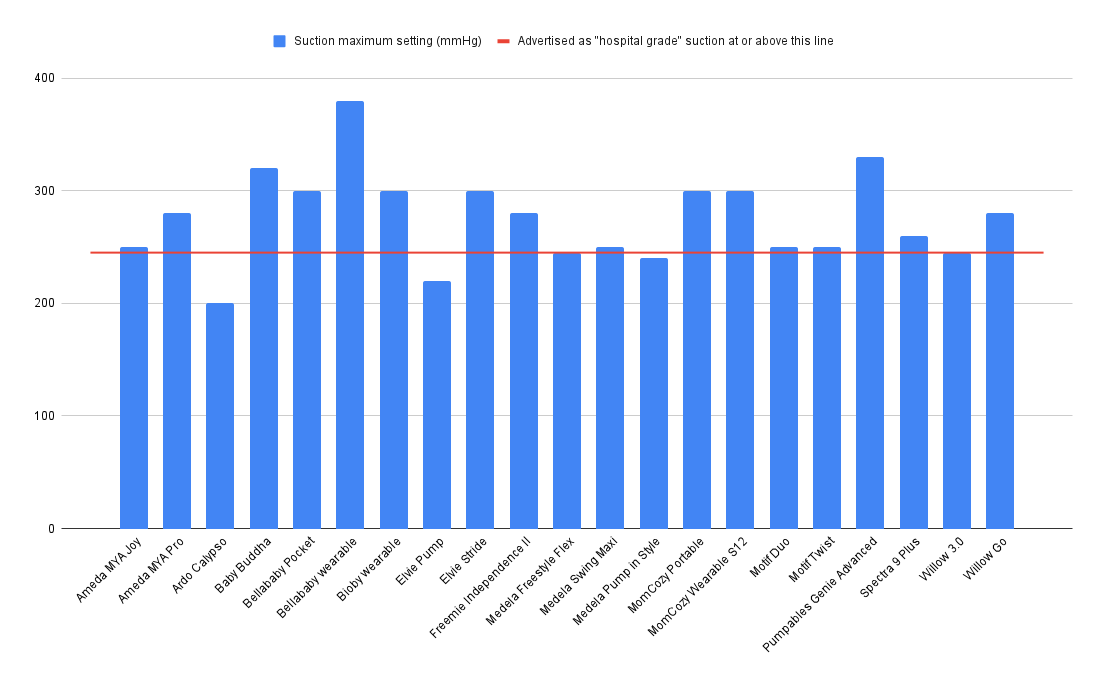With wearable pumps, is stronger suction actually better?
How the pursuit of stronger suction isn't the cure-all some lactating people (and advertisers) think it is.
When comparing pumping strength for wearable and portable pumps, I charted the maximum suction strength and price for every major-brand (and some minor-brand) wearable and portable pump I could find on the market. Pumping strength and price had no correlation, and even suspiciously cheap pumps like the $59 BellaBaby had pumping strengths that rivaled all of their competitors.
Is stronger suction always better in a wearable breast pump?
When I was lactating, I started losing my milk when my son was about four months old. It made sense — he couldn’t nurse, we had been separated for his first days, and I was deep in the throes of post-partum depression. The conditions weren’t ideal for a healthy longterm pumping lifestyle.
But I didn’t care. I was determined to break through the wall my body had created, through hell or high water. Among many strategies I (incorrectly, stubbornly) used was always setting my pump to the highest settings, even when it hurt. Especially when it hurt. No pain, no gain, I deluded myself.
It didn’t work. It probably sped up my milk decline. It certainly damaged my body and left me rubbed raw or actually bleeding.
The rise of wearable and portable pumps has freed lactating parents to multitask while pumping. Nearly every company that produces traditional breast pumps has created a wearable and/or portable breast pump to meet growing consumer demand.
Each seems to have a bit of a different design and specialization focus, but one feature stands out as an in-demand feature for these pocket-sized pumps: Strong suction. The stronger, the better, it seems.
As more pumps are released, the features vary company to company, but one trait keeps increasing with new versions: Pumping strength maximums.
Suction tops out at about 200 mmhg for most personal pumps, but some of the newest “hospital-grade” portable pumps range from 245 mmhg to nearly 400 mmhg.
What do lactation experts say about these maximum settings?
“Suction is not the be all end all, and more is not always better here,” said Kathleen Farmer, a board-certified lactation consultant in the San Francisco Bay Area. “When we’re talking about breast milk suction, most parents who are pumping use a very small range of suction.
“A lot of pumps go up to 200 [mmhg], 250, or 300. Almost no one is going to use that high of a range,” she said. “Most will use under 200.”
Farmer said using maximum suction can cause bruising or cuts to the nipple or areolas, and this can leave the breasts vulnerable to an infection such as mastitis.
The proper way to use suction, she said, is to raise the suction until the first sign of discomfort and then turn the suction down. She said a pump should never be uncomfortable because pain means tissue damage and because pain signals block the brain’s production of oxytocin, which prompts the milk letdown.
Another factor to many new portable pumps is a focus on the term “hospital-grade” suction in the advertising of high-tech pumps.
The term “hospital-grade” typically means a closed-system pump with a motor strong enough for multiple users throughout the day, such as in a hospital environment. It has also become synonymous with strong suction, but the term itself is an unregulated phrase that isn’t backed up by the FDA, the agency responsible for approving breast pump safety.
Farmer said pumps phrased as “hospital-grade” often have better settings that provide letdown stimulation, but that is going to vary pump to pump.
A study published in Nature in 2016 stated the most likely group to benefit from hospital-grade breast pumps are lactating parents who are separated from their baby or whose baby is unable to nurse, so the pump has to do all the heavy lifting. Otherwise, a personal pump with less suction would likely be a better fit.
“The motor is going to be better able to handle replacing the baby,” Farmer said.






“No pain, no gain, I deluded myself.” Oh man, so me. The determination and desperation to provide breastmilk is so palpable, even today.